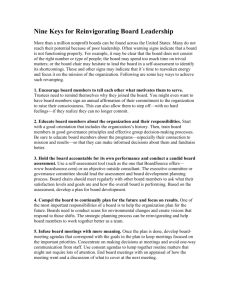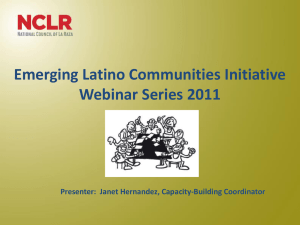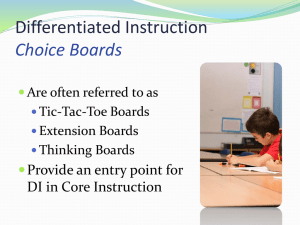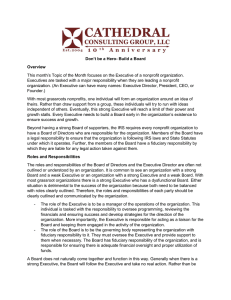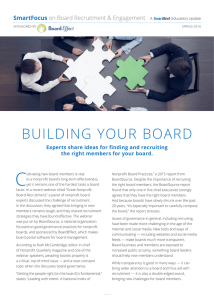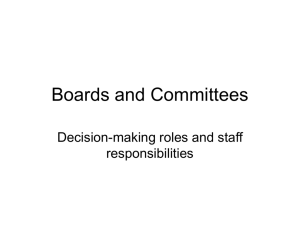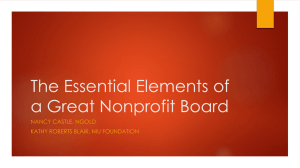Motivating Board Members and Volunteers
advertisement
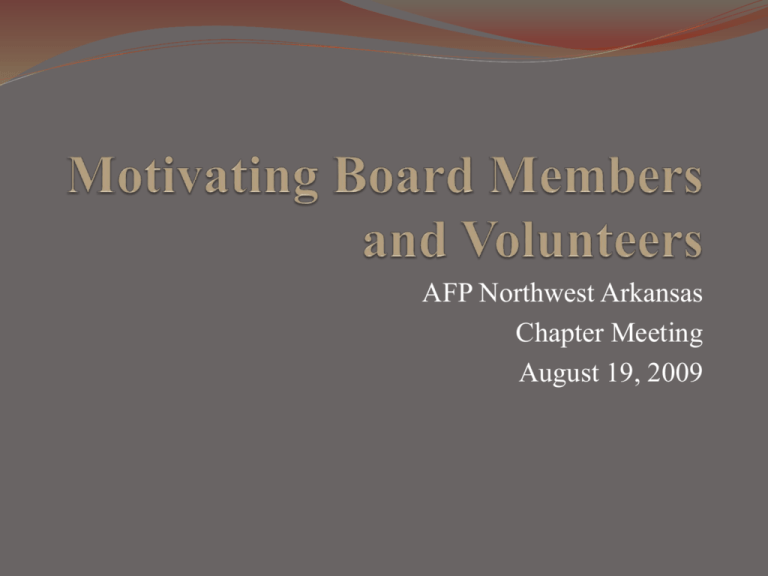
AFP Northwest Arkansas Chapter Meeting August 19, 2009 A Quick Survey How many serve on a non-profit board? 1 year 3-5 years 5-10 years 15+ years Survey Were recruited well Recruiter Explained the mission Outlined the responsibilities Financial Organizational Commitments Were not recruited well Recruiter Assumed a lot Used guilt Survey Prior to joining, did you know the executive director and board chair? Did you know whether you could work with them and that your opinion mattered? Does your idea about management fit with the way the organization operates? Survey Do principal staff provide timely and effective communication? Is their follow-up timely and effective? Do they “walk the talk” of the organizational mission? Advantage Based on your own board experience, you are uniquely positioned To appropriately staff and service your non- profit board To evaluate, understand, and strengthen the causes of successful boards To evaluate, understand, and change the causes of dysfunction Purpose for today’s discussion Think and act BEYOND the board agenda or the volunteer task… What can you do – easily – to make the board or committee as a whole, or even a few individuals work better? Mission = Motivation If you aren’t passionate about the nonprofit’s mission, the weight of your responsibilities likely will outweigh the benefits. Killick Datta, board member Direct Relief International Your board should… Strive towards representation that reflects your organization’s constituents Be committed to the mission and dedicated to the success of your organization Actively develop an understanding of the mission, ongoing activities, finances and operating environment of the organization Your board should… Value diversity and understand the role of participation and inclusion Demonstrate their personal stake in the organization through volunteer time, financial contributions and raising funds externally So… If this is what they should be doing, how do you help assure that they are motivated to do so? Four Things Lead by example Communicate effectively Assess individual involvement and satisfaction Recognition Lead by Example EVERYTHING you do matters; sets the tone Starting meetings on time Sending agendas and materials out well in advance Being responsive in returning phone calls and emails Routinely including and informing the board chair Lead by Example EVERYTHING you do matters; sets the tone… Not using blame or guilt to motivate Making sure all voices and opinions are heard Avoiding the “rubber stamp” syndrome or reputation Hiring staff that reflects diversity and inclusion Walking the talk of the mission Remember… Model the behavior you want to see and experience in the board… Communicate Effectively Clarity Any assignment or decision should be clearly articulated and captured in writing so all understand responsibilities and expectations Consistency On overload, human nature responds positively to repetition and predictability Evaluate the timing and look of all communication Communicate Effectively Persistence Easy to simply drop an idea or commitment if there is “whining” from a few Find ways to help the chair or committee chairs communicate the value and keep pressure on Time You have enough when it comes to communicating with your board. Use it; make it Assess Individual Involvement & Satisfaction Respect the board as individuals who bring a wealth of experience and variety of skills to the table Make sure roles and responsibilities are clearly defined Identify those few who are “fringe” players and invest your time and concern to bring them closer; to engage Recognition Be public with your recognition and positioning of board members. Web Program book Recognition wall The National Study of Nonprofit Governance Board Practices in the Nonprofit and Voluntary Sector in Canada Conducted by Strategic Leverage Partners Inc. in conjunction with the Centre for Voluntary Sector Research and Development May 2006 Fully Engaged Boards Have policies that provide sufficient guidance to the board, are reviewed on a more regular basis and are publicly disclosed. Are better able to read and understand financial statements, are required to sit on at least one committee and require less lead time to carry out their responsibilities effectively. Spend more time on board education and development, and the person responsible for briefing the board is effective. Fully Engaged Boards Conduct formal board evaluations and evaluate their CEOs based on preset criteria. Have formal risk management and crisis management policies and have assigned risk management and crisis management responsibilities to a specific individual or group. Have a strategic vision for the organization and have translated their strategic goals into measurable objectives and benchmarks for the board to monitor. Fully Engaged Boards Set annual objectives for the board, and the board or its committees follow a well-delineated work plan that outlines how the board will achieve its goals. The work plan becomes the board’s agenda for the year. Spend more time at board meetings in lively debate of strategic issues. Are not dominated by one or two people. Operate with a balanced budget.
